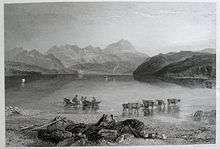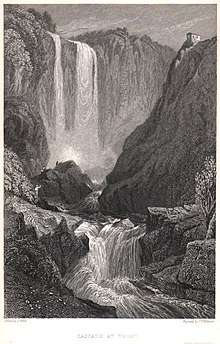James Tibbits Willmore
James Tibbits Willmore ARA (Birmingham September 1800 – 12 March 1863 London) was a British engraver.[1] [2]
He was born at Bristnal's End, Handsworth (then Staffordshire, now West Midlands).


His father, James Willmore, was a manufacturer of silverware. At the age of fourteen Willmore was apprenticed to the Birmingham engraver William Radclyffe. His younger brother Arthur Willmore (1814–1888) trained with him, and also became an engraver. Radclyffe had received drawing lessons in Birmingham from Joseph Barber. He married, and in 1823 he went to London where he worked for Charles Heath for three years. He later worked on the plates of William Brockedon's Passes of the Alps and Turner's England and Wales.
He made engravings after Chalon, Leitch, Stanfield, Landseer, Eastlake, Creswick and Ansdell, and especially after Turner. Willmore engraved thirteen pictures on copper for Turner's England and Wales series, beginning in 1828, and eight on steel for his Rivers of France. He made a number of large single plates after Turner, including Ancient Italy in 1842. The next year he exhibited this print at the Royal Academy (the first he had shown there), and was elected an associate engraver of the academy.[3]
References

- "WILL´MORE, JAMES TIBBITS". The New International Encyclopædia. 20. 1909. p. 541.
- 'Obituary: Mr. James Tibbetts [sic] Willmore, ARA', The Art Journal, May 1863, pp. 87–88.
- Joll, Evelyn; Butlin, Martin; Hermann, Luke, eds. (2001). The Oxford Companion to J.M.W. Turner. Oxford: Oxford University Press. ISBN 0-19-860025-9.